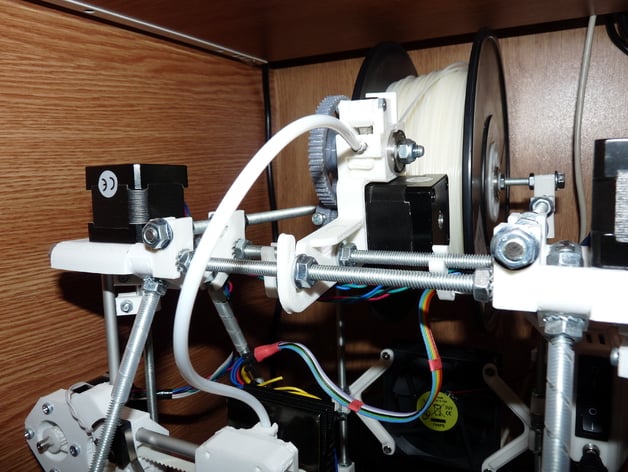
FD-626 - Filament Driver
thingiverse
When I received my very first 3D printer kit, which was a RepRapPro Huxley and became Huxy 1 (now you may got a glue of where the name of Huxy is coming from), I was very happy and amazed of various things in the pack. The most exciting was the "extruder driver" - well, I prefer to call it "filament driver", cause that it is :) A very nice piece of engineering, with tiny 623 bearings, though very compact. After assembling everything and get the first prints the problem appeared. The driver was designed to be mounted on the side of the printer, hence the filament spool would have to stay somewhere on the left of the printer, but there was no way to attach it (the spool) to the printer frame. So, I thought something has to be done and this was two fold: place the driver on top of the printer; create a spool holder and attach it to the frame, somehow on the backside. However, while building Huxy 2 and 3, another problem appeared. 623 bearing are not so common, at least here in Romania. So, I decided to compromise a bit the compactness, and went for 626. It was also that the M3 screw that implemented the driving spindle, was somehow too little for such a big duty, and signs of wear appeared at the free end of the thread (due to friction with the inner ring of the bearing. So, this is how FD-626 was born. It's the revision C that you could see in the picture (there is also the spool holder visible, but this will be another thingy story). Differentiating characteristics: compactness (there is no significant increase in size due to changing the bearing type) easy to source parts (particularly 626 is much easier to find than 623, and cheaper most of the times) more robust driving spindle (M6) same gear ratio as the original (actually same gear parameter values, except that I preferred exterior teeth for the large gear, so that I can have better grip when having to manually rotate the gear) hence you can directly replace the original without calibrating the feed rate (well, there could be differences produced by the hobbed piece) directly attachable on the upper transversal rods (the design is for Huxley, but could be easily adapted for other A-framed RepRaps) easily disengagement of the filament - there are no screws to adjust pressure or to hold the idler, you just press the tensioner and the filament can be pushed of pulled freely (one hand operation of the driver, so the other one can take care of the filament) NEMA 14 stepper motor, as in the original design; well, not so easy to find a good one, but by far more compact than NEMA 17, you know that ;) There is one issue I know, but I didn't find it very disturbing: you have to dismantle the driving axle to reach 2 of the 4 motor mounting screws. Well, that's all coming to my mind for now :) Instructions Vitamins 1 x M6x40 screw, as driving spindle 2 x 626 bearings, for driving spindle 1 x hobbed barrel, see info below 1 x M6 nyloc nut, to lock the spindle 1(2) x M6 washer(s), to adjust position of the barrel on the axle, as necessary 1 x 626 bearing as pinch roller (idler) 1 x 9mm piece of M6 threaded rod, as idler spindle 1 x M3x20 screw, as tensioner spindle 1 x M3 nut, to lock the tensioner spindle 1 x 5/6/0.5mm 7 turns spring (length ~10mm), as tensioner spring (this has to be tough, as it provides the pressure on filament) 1 x5/5.4/0.2mm 7 turns spring (length ~10mm), as idler spring (this is softer, it gently pushes the idler back when you press the tensioner to release the filament) 1 M3x8(10) (grub) screw to lock the small gear on the motor spindle 1 M3 nut to lock the small gear on the motor spindle 4 x M3x8 screws to attach the stepper motor 1 x NEMA 14 small but mighty stepper motor 4 x M6 nuts to attach the driver on the upper transversal rods (on Huxley models) All plastic parts print well with a 0.5 mm nozzle, and 40% infill, except for the gear, for which I would recommend 80% infill. The body should be printed with support, and you will have to work a bit to clean it. Pay attention not to cut/break the small retainers that keeps the tensioner on its sliding path! Well, if you are interested, I can make a more consistent tutorial about "how to make it" (so, please let me know), but for now that is all.
With this file you will be able to print FD-626 - Filament Driver with your 3D printer. Click on the button and save the file on your computer to work, edit or customize your design. You can also find more 3D designs for printers on FD-626 - Filament Driver.
